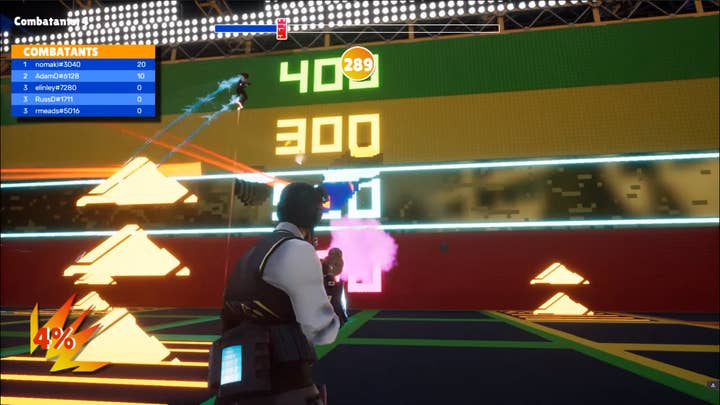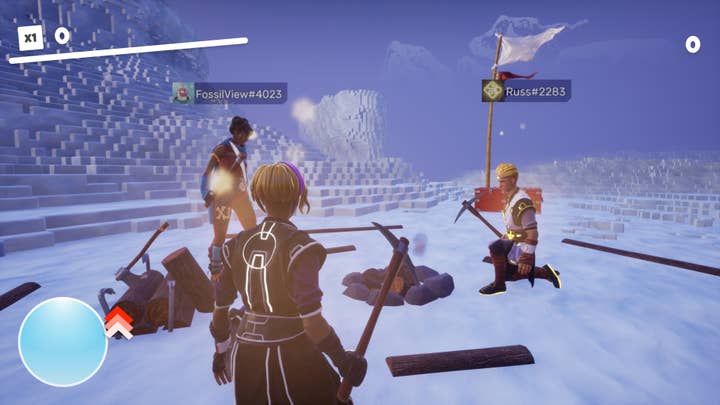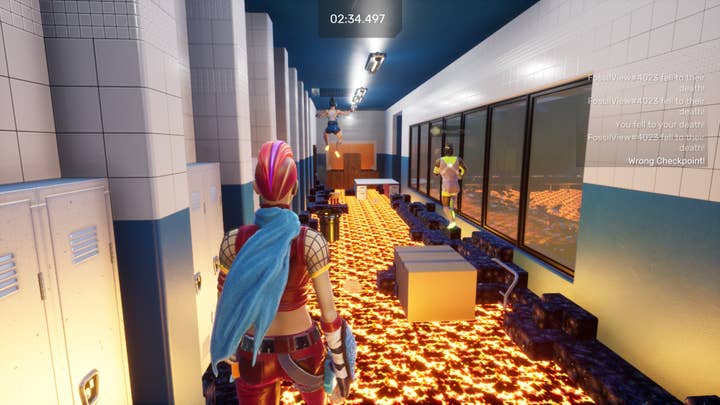Crayta's cloud-driven dream to democratize game development
Unit 2 Games and Crayta's Indie Fund developers discuss the platform's inception and hopes for an accessible future
As Unit 2 Games neared the finish line of development on its game creation platform, Crayta, its goal was to "democratize game development." It wanted to make a space where anyone could make a game quickly and easily, and share it with others.
To that end, the cloud gaming capabilities of Google Stadia -- with its State Share feature, now in beta, allowing users to create links that transport others directly into their games -- made perfect sense. But that left them with a problem to solve. At launch, Crayta would be a game creation platform with absolutely no games on it. How, then, could the team prove to its incoming audience that the platform was good?
Thus, the Crayta Indie Fund was born. Unit 2 offered £100,000 to existing independent developers to create games on Crayta, for Crayta's launch. The fund ended up split between eight studios, all with varying team sizes and levels of experience, and all of whom made brand new games only available through Crayta when it launched on July 1.
Speaking to GamesIndustry.biz, Spilt Milk's Andrew Smith, Double Blit Games' Fernando Melo, and Team Cats & Bears' Johnny Wallbank shared their experience working on the platform, along with Crayta's first Prize Fund winner Bryant Chappell, Unit 2 publishing director Chris Swan, and brand and marketing director Natalie Griffith.
Each of the three Indie Fund recipients cited a different reason for being drawn to the platform. For Smith, it was curiosity about the new technology -- and he adds later that the Indie Fund money let Spilt Milk fill a gap on their team by bringing on a new coder. For Wallbank, it was Unit 2's history of inclusivity and commitment to accessibility, something he's been passionate about in past games and wanted to specifically focus on with Crayta. For Melo, who had just started his studio, it was a chance for his team to start working on something immediately that came with funding baked in.

All three developers say that using Crayta gave them the ability to more easily tackle certain challenging development issues that were common on other platforms. Wallbank specified the ease with which he was able to get multiplayer games up and running.
"Normally there's a big windup time in terms of developing all the backends and all the frameworks for it," he says. "It's a huge milestone...but that was just taken care of, and I think we were doing group play tests within the first week or two of development."
"Being able to chat with other developers, see how they did something, and then borrow some of that was just incredible"
Fernando Melo
Melo focuses on the collaborative aspects of the platform, combined with Stadia State Share and cloud capabilities. The group tells me that all the Indie Fund developers would have Friday meetings to playtest one another's games, all held in a Crayta map they'd meet on, including putting questions up on a stage and providing feedback.
"Oftentimes, a lot of the issues that you tend to deal with in traditional game development are around collaboration, like two people trying to work in the same level," Melo says. "It's been decades since we've been making games, and yet fundamental things like that can be so painful sometimes. Or you overwrite each other's code or whatever the case is to solve all of that stuff, and the online aspect of it is a whole other can of worms.
"...[But with Crayta] it just works out of the box and is largely abstracted away. You don't even need to worry about it. And the toolset itself is really robust, the assets that are in there, the community aspect of it, and just being able to chat with other developers, open up some of their things and see how they did something, and then be able to borrow some of that was just incredible."
"One of the first games I made, I was having issues... Within seconds somebody was in my code saying, 'Yup, here's your problem'"
Bryant Chappell
Swan tells me that for Unit 2, the Indie Fund was the first step. It was important to prove that the platform worked on a certain level for people who already knew how to make games without the toolsets causing too many restrictions. But then came the next step. The platform had to be accessible to people who had never made a game before.
Fortunately, after launch, a perfect proof manifested in Chappell. Chappell is a content creator who had been in on Stadia since the Founder's Edition, so he jumped into Crayta and sharing his creations via State Share with his audience. And he eventually created The Floor is Lava, which won him Crayta's Prize Fund for July as the platform's most popular game that month -- an honor he won despite having never made a video game before Crayta or having any game development or coding training whatsoever.

"One of the first games I made, I was having issues with it," he says. "I posted in the forum and they jumped straight in there and within seconds somebody was standing there in my code saying, 'Yup, here's your problem.'"
Griffith adds: "I think the State Share beta has really helped us engage with the community as well, because not only can you have more traditional community engagement channels like Discord, but if somebody pops on Discord and says, 'I'm struggling, my code's not working, I don't know why,' one of the team can get the community member to share their State Share Beta link, and then we jump in and live code with them and teach them how to do it better in the future."
"We love to say the whole point of it is democratizing [game development], but we also see the potential that anyone, even experienced developers, can use it"
Natalie Griffith
For right now, the Prize Fund -- which rewards the top games and top new games on Crayta each month with monetary prizes -- is the only way to monetize a game on Crayta. Swan suggests that while Unit 2 will carry on with the fund for the foreseeable future, it's likely that the studio will eventually either add to it or move away from it entirely to give creators more flexibility in how they monetize.
"It was a good statement of intent from us," he says. "It shows the direction we want to go in. If we went straight to, 'Hey, creators, you need to monetize your games,' there's going to be extra complexity for them to get the hang of. But also, we may have inadvertently created a bit of a pay-to-win rush, which we didn't want to do. We wanted the games to stand on their own creativity and addictiveness first."
The team acknowledges that Crayta's Prize Fund -- which maxes out at a $5,000 prize for the top game each month and smaller prizes for others -- is probably not a viable option for an entire studio to stake development on right now. But that's not the point. Rather, Griffith says the fund was there to get the platform started, and ultimately Crayta is mainly about simply providing the tools to anyone who wants them.
"We don't see any reason why other indies [couldn't use Crayta], whether they're multiple studios that want to use it as a game jam tool, or want to use it to prototype on, or one-man-bands that want to experiment, or maybe they're indie devs and they're doing that in their spare time," she says. "It's not just for newcomers noodling. Although that's brilliant, and we love to say the whole point of it is democratizing [game development], we also see the potential that anyone, even experienced developers, can...use it."
"We can't truly democratize game creation if it's a finite system of what you can actually build with"
Chris Swan
Chappell adds: "The prize fund was never what drew me to the idea of making a game. It was just getting in there and learning something new. When I first heard about this game, the folks at Unit 2 kept using that term, 'the democratization of gaming.' Learning to become a developer or learning to code, oftentimes, there are paywalls [in the form of] going to college or going to school. And one of the things that Crayta and Stadia provides is you can just jump in there and you can learn how to make a game. That's almost more important than in the prize fund in a way, and is why I have the confidence to be able to jump back in and create something else."
Swan and Griffith acknowledge that Crayta still has some limitations. Swan says it's still very character-based, relying on player characters to interact with game worlds. He wants to widen that scope over time, though, adding capabilities like vehicle support, and he says that players are already finding ways to subvert other limitations like the reliance on 3D.
"We're in this as a long play, obviously -- it's user-generated content," Griffith adds. "It's not a ship-it-and-walk-away kind of job... We've got a huge wishlist of things we want to put in ourselves, but also, from day one we launched a community feedback area as well... As we go forwards, we're going to be combining the things that the community are really asking for and the things we want to do, can do, and are able to do and drive it forward that way."

Swan also suggests the team is considering letting users import their own assets in the future.
"We can't truly democratize game creation if it's a finite system of what you can actually build with," he says. "We think we need to go wider than that. And either we are trying to constantly play catch up with what people are requesting, or we open up to people to put in what they desire for their games."
Updates aside, the developers and Crayta's creators all have bright visions for what they hope to see in the platform's future. Swan wants to see it push boundaries and potentially change games as a medium. Chappell wants to see how it democratizes not just game creation, but content creation -- "There could be the next big AAA creator that gets their start from Crayta," he says.
"I'd hope that we get to see some new voices, because the world is always richer for having more diverse voices"
Johnny Wallbank
Wallbank wants Crayta to follow through on the commitment to accessibility and diversity he's seen from Unit 2 in the past.
"I hope it will see a really broad and diverse range of voices," he says. "That's something that, as far as I can tell, has been present throughout everything I've seen from Unit 2... With the engine being so focused on accessibility, I'd hope that we get to see some new voices because the world is always richer for having more voices and more diverse voices."
Griffith notes that the team has already made some positive inroads on that front. The studio has already announced a separate prize fund for Black creators, and affirms the studio wants to elevate diverse voices that don't always get the opportunity to make games for any number of reasons, whether those are social, financial, technical, creative, or otherwise.
"We've got some tests going on at the moment that will allow disabled people to use the creation tools as well as just play," she says. "I would love to see at some point a disabled gamer not just being able to access games, but be able to create games that other people enjoy and make money from that.
"We've got this technology, the EyeMine controller...that proved out that technology [could be used] to place blocks and create stuff in Minecraft with just your eyes. If we had somebody who only had control of their eyes physically and could make a game and make money from that, that would be incredible."
After our interview, Griffith reached back out to me to let me know that the accessibility she had posited had already come to fruition. Just last week, SpecialEffect ambassador Becky "EyeGazeGirl" Tyler submitted a game to the Crayta game jam made entirely using eye gaze technology. A few days later, she posted a video of herself recreating the set from musical Into the Woods in Crayta using the same tech:


